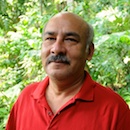LIMA, Peru (19 December, 2011)_On a sunny, windy day in late September 2005, Don Angel Rodriguez, a farmer in the village of Zapotillo in the Peruvian Amazon lost most of his family’s economic assets: a 20-hectare plantation of the fast-growing construction timber Guazuma crinita that was close to harvest, the family’s ripening banana and plantain fields, and their entire herd of cows, to a fast-moving fire that swept across the village and through his property.
This was a devastating shock to the family’s economic fortunes, but it paled in comparison to the losses of the Rodriguez family’s neighbors, the Pezos. Don Ramon Pezo, who had earlier responded to a call from Angel for help — saving the Rodriguez home and housegarden from flames — lost his life, reportedly while trying to save his own home, cassava fields, and the orange and peach palm groves behind the house. Angel found Don Ramon’s body in front of the Pezo home. Angel believes that he was overcome by smoke when he raced from the orchards he was trying to protect toward the house that was just catching fire.
The western Amazon, including the lowland Peruvian Amazon, had long been considered safe from the kinds of fires that have ravaged the eastern Amazon Basin for decades. With high total rainfall, less pronounced dry seasons and extensive areas of mature forests, the state of Acre in Brazil, as well as the Peruvian and Bolivian Amazon have rarely suffered extensive destructive fires. But then came the drought of 2005. That year saw the burning of over 300,000 ha of forest in the Brazilian state of Acre as well as of extensive areas in neighboring parts of Peru. Economic losses reportedly totaled more than $50 million in Acre alone.
In the same year, Peruvian government sources reported, more than 22,000 ha burned in just one province in Amazonia. While this is a large area, it is probably a serious underestimate. Of the officially recognized burned area, about 16,000 ha were in forest, more than 5,000 in pasture, and the rest were fruit plantations, manioc fields, banana gardens, and the villages and homes of farming families. The 2005 drought and the subsequent and even even more extreme 2010 drought, were indeed exceptional weather events, but droughts of comparable magnitude had occurred in the western Amazon in earlier years, with far fewer fires, and much less destruction noted. And since 2005 fires have been burning forests and farms every year, whether rainfall is exceptionally low or not. What has changed?
The western Amazon, like many tropical, forested areas of the world appears to be in the grips of a “perfect (fire)storm” of changes that have come together to turn fire, long an indispensable tool of farmers, into an enemy and increasingly a reason to leave the countryside entirely for an often precarious existence in urban slums. Fire is also the reason why many traditional forms of land use, especially the locally-developed, highly diverse, productive, and sustainable forms of Amazonian forest and agroforestry management that we have spent decades studying, disappear from many areas in favor of more pastures, or often, transformation into degraded lands that are simply abandoned. And each destructive fire makes the once seemingly invulnerable western Amazon forests more susceptible to drying and to further burning.
In the Peruvian Amazon many interrelated patterns are in flux: land use, land cover, tenure, residence, migration, and social cohesion are all changing, along with weather shifts that may signal a trend toward more pronounced dry seasons. Large ranchers who typically now live far away in cities tend to employ only a very few caretaker managers who set fires to manage both vegetation and pest buildup, and do not have the personnel to stop the conflagration when it escapes the ranch’s boundaries. Small family farms are frequently understaffed as well, with household members spending more time in cities, unavailable to manage fires and build firebreaks. Many of those who do live in villages are recent migrants from outside the region and often these newly diverse village populations no longer come together to form groups to help with fire management until, as in the case of Zapotillo, it is too late.
So, while the need for a solution is ever more urgent, the reasons for the destruction remain perplexingly complex and difficult, prompting most policymakers to grasp for easy solutions. A ready “solution” is to blame the small farmer and just ban the use of fire. While temptingly straightforward, this frequently adopted policy option has simply not worked in the area. Fire as a tool is too easily at hand, too difficult to trace, too hard to stop while effective alternative tools for smallholder farming and equally cheap tools for large ranching remain difficult to come by.
The complexity of the problem actually offers several possible avenues for intervention. Some local governments like the state of Acre that informs farmers of special dangers by disseminating “burn calendars” and maintains accurate property data that fosters accountability, appears to be dealing more effectively than others with the threat. But in much of the western Amazon the fire situation is apt to get even worse before it improves and the Rodriguez family together with their neighbors will face the destruction, and doubtless the personal tragedies again.
httpv://www.youtube.com/watch?v=bB8948NXEuQ&feature=plcp&context=C36e1a6bUDOEgsToPDskJ7Y4mzKut4sBBJwKuK0iT8
We want you to share Forests News content, which is licensed under Creative Commons Attribution-NonCommercial-ShareAlike 4.0 International (CC BY-NC-SA 4.0). This means you are free to redistribute our material for non-commercial purposes. All we ask is that you give Forests News appropriate credit and link to the original Forests News content, indicate if changes were made, and distribute your contributions under the same Creative Commons license. You must notify Forests News if you repost, reprint or reuse our materials by contacting forestsnews@cifor-icraf.org.














